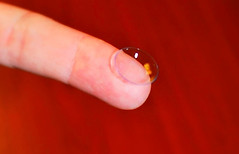

Child Eye Care Associates, LLC
Pediatric & Adolescent Ophthalmology
Adult Eye Muscle Disorders
Sophia Fang, MD Shawn Goodman, MD David Wheeler, MD Julie Yu, MD
Alexandra Bavasi, OD Sally Murray, CO
When to consider contact lenses:
-
The age at which it is appropriate for your child to start wearing contact lenses depends on the maturity, responsibility, and the motivation of the child. Most children have little difficulty handling contact lenses around age 12, but many can be successful at age 8. The child must not be afraid to touch his/her eye, and s/he must demonstrate excellent personal hygiene.
-
Children with strabismus and/or amblyopia may wear contact lenses. However, children who wear bifocal spectacles may not yet be good contact lens candidates, as additional reading glasses would likely be required.
-
Contact lenses may be contraindicated if the child has certain medical conditions, like congenital glaucoma, chronic uveitis, chronic conjunctivitis, or certain corneal diseases. Children with conditions requiring frequent eye drop instillation throughout the day are not good contact lens candidates.


Types of lenses we fit
-
We fit a large variety of “soft” contact lenses at Child Eye Care. We do not specialize in rigid or scleral fits; if these are required, we will refer you to our colleagues elsewhere who are contact lens specialists.
-
Types of soft contact lenses:
-
Spherical: Spherical lenses correct any combination of myopia and/or hyperopia.
-
Toric: Toric lenses correct for astigmatism. They are more difficult to fit, as the lenses need to orient a certain way on the eyes.
-
Multifocal: Multifocal lenses are typically used in adults who need reading glasses; however, they are used for children to help prevent myopia progression.
-
-
Other contact lenses we fit
-
Custom soft: Some prescriptions require extended ranges or custom fits.
-
Aphakic: These lenses are only used for infants/children who have undergone cataract surgery.
-
-
Replacement schedules
-
Daily disposable: The patient wears a brand-new pair of lenses every day. The lenses are thrown away at the end of the day. These lenses have the highest safety profile and are the first recommendation for most kids.
-
Monthly/biweekly replacement: The same set of lenses is worn for 1 month (or 2 weeks, depending on the brand). The lenses need to be cleaned and stored overnight every night. These lenses are more cost effective than daily disposable lenses.
-
Contact lens fitting process:
-
To be fit in contact lenses, your child will need to have had a recent comprehensive eye exam with his/her ophthalmologist or optometrist. This exam ensures we are using the most up-to-date information about your child’s eyes to determine if they are a good contact lens candidate.
-
The contact lens fitting is then completed on a separate day, as the first fitting appointment can take up to an hour and a half. Our optometrist, Dr. Bavasi, will educate you and your child about contact lens care/handling and then guide your child through learning how to apply and remove the lenses him/herself. The lenses used during your child’s first fitting appointment are real lenses that were chosen to reflect his/her prescription as accurately as possible. The child’s vision and the contact lens fit are then assessed.
-
Once your child can demonstrate that s/he can successfully insert and remove the lenses, and if the contact lenses are a good fit, then the trial lenses will be dispensed and your child will have 1-2 weeks to practice wearing them. The wear-time will be slowly increased each day.
-
In 1-2 weeks, your child will return for a contact lens follow up appointment to evaluate the contact lens fit, vision, and comfort. The contact lens trials must be worn to the follow up appointment for accurate assessment. If all is satisfactory, then care and handling are reviewed, and a contact lens prescription is written and released. The contact lens prescription is valid for one year. The prescription can be filled at Child Eye Care or at another practice/retailer of your choice.
-
Changes may need to be made to the lenses to provide optimal vision, comfort, and health. The prescription or brand of lenses may need to be changed. In these cases, new trial lenses will be dispensed. Further follow up visits may be necessary to ensure proper fit and health before finalizing the contact lens prescription. These follow up visits are included with the initial fitting fee.
-
Your child will need to return each year for his/her comprehensive exam in order to check the health of the corneas and make necessary prescription changes before updating/refilling the contact lens prescription.

_JPG.jpg)

Wearing contacts
-
Hands must be thoroughly washed with soap and water prior to handling contact lenses and/or touching the eye; this includes before inserting the lenses and before removing the lenses.
-
Sleeping overnight in contact lenses will result in ocular irritation; it also raises the risk of developing an eye infection by 7-10 times.
-
Swimming in contact lenses is prohibited. This includes pools, hot tubs, and natural sources. Small and dangerous microbes can infiltrate the contact lenses and cause serious, sight-threatening infections.
-
Lenses should be worn for no more than 12-14 hours per day. We recommend removing the contact lenses and wearing glasses a couple of hours before bedtime to allow the eyes to breathe normally.
Vision insurance vs. medical insurance for contact lens coverage
-
Child Eye Care is a medical specialist office; exams and services are billed through the patient’s medical insurance. Routine vision insurance is not billed.
-
Medical insurance will cover “medically necessary contact lenses” only. Patients with aphakia, high anisometropia (over 3 diopters difference in prescription between each eye), corneal ectasias/scars, or irregular astigmatism (not regular astigmatism) are able to have their contact lenses covered by their medical insurance.
-
Routine contact lens fittings can still be done! A contact lens fitting fee is due at the time of service. The fee varies depending on the difficulty of the fit (spherical vs. toric vs. multifocal). The fee includes contact lens application/removal training, contact lens care education, a free contact lens case and travel-sized solution, and covers as many follow up visits as may be required to find the most appropriate contact lens brand and prescription for your child. You can submit a receipt of the fitting fee to your child’s vision insurer for reimbursement.
-
Once the contact lens prescription is finalized, the contacts may be ordered at Child Eye Care or taken to the practice/retailer of your choice. After the contact lenses have been purchased, the receipt may then also be submitted to your child’s vision insurer for reimbursement.